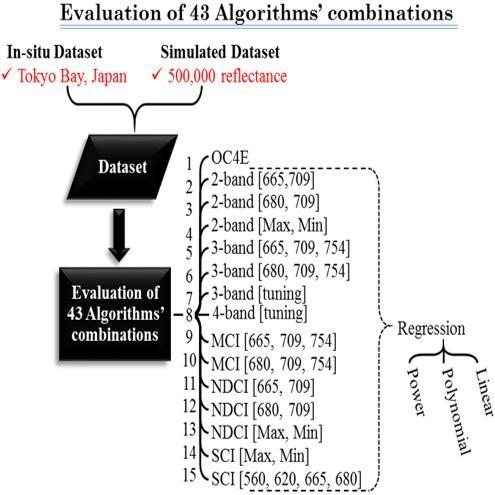Assessment of Chlorophyll-a Algorithms Considering Different Trophic Statuses and Optimal Bands
Abstract
:1. Introduction
2. Materials and Methods
2.1. Field and Laboratory Measurements
2.2. Bio-Optical Model
2.3. Simulating the Remote Sensing Reflectance
2.4. Candidate Chla Algorithms and Band Selection
2.5. Accuracy Assessment of the Algorithms
3. Results and Discussion
3.1. Algorithm Assessment with the Simulated Reflectance
3.1.1. Simulated Reflectance Assessment
3.1.2. Overall Performance
3.1.3. Algorithm Performance by Considering Chla and NAP
3.1.4. The Most Accurate Algorithms among Chla and NAP Combinations.
3.2. Algorithm Assessment with Field Measurements
3.3. Validity of the Simulated Reflectance Dataset’s Models on Chla Retrieval in Tokyo Bay
3.4. Comparing the Algorithms’ Performance for Measured and Simulated Datasets
4. Conclusions
Supplementary Materials
Acknowledgments
Author Contributions
Conflicts of Interest
Appendix A
References
- Zhou, Z.; Zhao, Y. Research on the Water Quality Monitoring System for Inland Lakes based on Remote Sensing. Procedia Environ. Sci. 2011, 10, 1707–1711. [Google Scholar] [CrossRef]
- Mannino, A.; Russ, M.E.; Hooker, S.B. Algorithm development and validation for satellite-derived distributions of DOC and CDOM in the U.S. Middle Atlantic Bight. J. Geophys. Res. 2008, 113, C07051. [Google Scholar] [CrossRef]
- Usali, N.; Ismail, M.H. Use of Remote Sensing and GIS in Monitoring Water Quality. J. Sustain. Dev. 2010, 3, 228–238. [Google Scholar] [CrossRef]
- Schroeder, T.; Schaale, M.; Fischer, J. Retrieval of atmospheric and oceanic properties from MERIS measurements: A new Case-2 water processor for BEAM. Int. J. Remote Sens. 2007, 28, 5627–5632. [Google Scholar] [CrossRef]
- Boyer, J.N.; Kelble, C.R.; Ortner, P.B.; Rudnick, D.T. Phytoplankton bloom status: Chlorophyll a biomass as an indicator of water quality condition in the southern estuaries of Florida, USA. Ecol. Indic. 2009, 9, S56–S67. [Google Scholar] [CrossRef]
- Dekker, A.G.; Phinn, S.R.; Anstee, J.; Bissett, P.; Brando, V.E.; Casey, B.; Fearns, P.; Hedley, J.; Klonowski, W.; Lee, Z.P. Intercomparison of shallow water bathymetry, hydro-optics, and benthos mapping techniques in Australian and Caribbean coastal environments. Limnol. Oceanogr. Methods 2011, 9, 396–425. [Google Scholar] [CrossRef]
- Morel, A.; Prieur, L. Analysis of variations in ocean color. Limnol. Oceanogr. 1977, 22, 709–722. [Google Scholar] [CrossRef]
- Gordon, H.R.; Morel, A. Remote Assessment of Ocean Color for Interpretation of Satellite Visible Imagery. A Review; Lecture Notes on Coastal and Estuarine Studies 1983; Springer: Berlin, Germany, 1983. [Google Scholar]
- Matsushita, B.; Yang, W.; Chang, P.; Yang, F.; Fukushima, T. A simple method for distinguishing global Case-1 and Case-2 waters using SeaWiFS measurements. ISPRS J. Photogramm. Remote Sens. 2012, 69, 74–87. [Google Scholar] [CrossRef] [Green Version]
- O’Reilly, J.E.; Maritorena, S.; Mitchell, B.G.; Siegel, D.A.; Carder, K.L.; Garver, S.A.; Kahru, M.; McClain, C. Ocean color chlorophyll algorithms for SeaWiFS. J. Geophys. Res. 1998, 103, 24937. [Google Scholar] [CrossRef]
- Gordon, H.; Brown, J.; Brown, O.; Evans, R.; Smith, R. A semianalytic radiance model of ocean color. J. Geophys. Res. 1988, 93, 10909–10924. [Google Scholar] [CrossRef]
- Zeng, C.; Xu, H.; Fischer, A.M. Chlorophyll-a Estimation Around the Antarctica Peninsula Using Satellite Algorithms: Hints from Field Water Leaving Reflectance. Sensors 2016, 16, 2075. [Google Scholar] [CrossRef] [PubMed]
- Gons, H.J. Optical Teledetection of Chlorophyll a in Turbid Inland Waters. Environ. Sci. Technol. 1999, 33, 1127–1132. [Google Scholar] [CrossRef]
- Gitelson, A.A.; Dall’Olmo, G.; Moses, W.; Rundquist, D.C.; Barrow, T.; Fisher, T.R.; Gurlin, D.; Holz, J. A simple semi-analytical model for remote estimation of chlorophyll-a in turbid waters: Validation. Remote Sens. Environ. 2008, 112, 3582–3593. [Google Scholar] [CrossRef]
- Dall’Olmo, G.; Gitelson, A.A.; Rundquist, D.C. Towards a unified approach for remote estimation of chlorophyll-a in both terrestrial vegetation and turbid productive waters. Geophys. Res. Lett. 2003, 30, 1938. [Google Scholar] [CrossRef]
- Oki, K.; Yasuoka, Y. Estimation of Chlorophyll-a Concentration in Rich Chlorophyll Water Area from Near-infrared and Red Spectral Signature. J. Remote Sens. Soc. Jpn. 1996, 16, 315–323. [Google Scholar]
- Gons, H.J.; Auer, M.T.; Effler, S.W. MERIS satellite chlorophyll mapping of oligotrophic and eutrophic waters in the Laurentian Great Lakes. Remote Sens. Environ. 2008, 112, 4098–4106. [Google Scholar] [CrossRef]
- Matthews, M.W. A current review of empirical procedures of remote sensing in inland and near-coastal transitional waters. Int. J. Remote Sens. 2011, 32, 6855–6899. [Google Scholar] [CrossRef]
- Gholizadeh, M.H.; Melesse, A.M.; Reddi, L. A Comprehensive Review on Water Quality Parameters Estimation Using Remote Sensing Techniques. Sensors 2016, 16, 1298. [Google Scholar] [CrossRef] [PubMed]
- Lee, Z.; Carder, K.L.; Arnone, R.A. Deriving Inherent Optical Properties from Water Color: A Multiband Quasi-Analytical Algorithm for Optically Deep Waters. Appl. Opt. 2002, 41, 5755. [Google Scholar] [CrossRef] [PubMed]
- Loisel, H.; Vantrepotte, V.; Ouillon, S.; Ngoc, D.D.; Herrmann, M.; Tran, V.; Mériaux, X.; Dessailly, D.; Jamet, C.; Duhaut, T.; et al. Assessment and analysis of the chlorophyll-a concentration variability over the Vietnamese coastal waters from the MERIS ocean color sensor (2002–2012). Remote Sens. Environ. 2017, 190, 217–232. [Google Scholar] [CrossRef]
- Garver, S.A.; Siegel, D.A. Inherent optical property inversion of ocean color spectra and its biogeochemical interpretation: 1. Time series from the Sargasso Sea. J. Geophys. Res. Ocean. 1997, 102, 18607–18625. [Google Scholar] [CrossRef]
- Werdell, P.J.; Bailey, S.W.; Franz, B.A.; Harding, L.W.; Feldman, G.C.; McClain, C.R. Regional and seasonal variability of chlorophyll-a in Chesapeake Bay as observed by SeaWiFS and MODIS-Aqua. Remote Sens. Environ. 2009, 113, 1319–1330. [Google Scholar] [CrossRef]
- Oki, K.; Yasuoka, Y.; Tamura, M. Estimation of Chlorophyll- a and Suspended Solids Concentration in Rich Concentration Water Area with Remote Sensing Technique. J. Remote Sens. Soc. Japan 2001, 21, 449–457. [Google Scholar]
- Oki, K. Why is the Ratio of Reflectivity Effective for Chlorophyll Estimation in the Lake Water? Remote Sens. 2010, 2, 1722–1730. [Google Scholar] [CrossRef]
- Ha, N.; Koike, K.; Nhuan, M. Improved Accuracy of Chlorophyll-a Concentration Estimates from MODIS Imagery Using a Two-Band Ratio Algorithm and Geostatistics: As Applied to the Monitoring of Eutrophication Processes over Tien Yen Bay (Northern Vietnam). Remote Sens. 2013, 6, 421–442. [Google Scholar] [CrossRef]
- El-Alem, A.; Chokmani, K.; Laurion, I.; El-Adlouni, S.E. Comparative analysis of four models to estimate chlorophyll-a concentration in case-2 waters using MODerate resolution imaging spectroradiometer (MODIS) imagery. Remote Sens. 2012, 4, 2373–2400. [Google Scholar] [CrossRef]
- Watanabe, F.; Alcântara, E.; Rodrigues, T.; Imai, N.; Barbosa, C.; Rotta, L. Estimation of Chlorophyll-a Concentration and the Trophic State of the Barra Bonita Hydroelectric Reservoir Using OLI/Landsat-8 Images. Int. J. Environ. Res. Public Health 2015, 12, 10391–10417. [Google Scholar] [CrossRef] [PubMed]
- Chen, J.; Zhang, X.; Quan, W. Retrieval chlorophyll-a concentration from coastal waters: Three-band semi-analytical algorithms comparison and development. Opt. Express 2013, 21, 9024–9042. [Google Scholar] [CrossRef] [PubMed]
- Zhou, L.; Roberts, D.A.; Ma, W.; Zhang, H.; Tang, L. Estimation of higher chlorophylla concentrations using field spectral measurement and HJ-1A hyperspectral satellite data in Dianshan Lake, China. ISPRS J. Photogramm. Remote Sens. 2014, 88, 41–47. [Google Scholar] [CrossRef]
- Le, C.; Li, Y.; Zha, Y.; Sun, D.; Huang, C.; Lu, H. A four-band semi-analytical model for estimating chlorophyll a in highly turbid lakes: The case of Taihu Lake, China. Remote Sens. Environ. 2009, 113, 1175–1182. [Google Scholar] [CrossRef]
- Mishra, S.; Mishra, D.R. Normalized difference chlorophyll index: A novel model for remote estimation of chlorophyll-a concentration in turbid productive waters. Remote Sens. Environ. 2012, 117, 394–406. [Google Scholar] [CrossRef]
- Augusto-Silva, P.B.; Ogashawara, I.; Barbosa, C.C.F.; de Carvalho, L.A.S.; Jorge, D.S.F.; Fornari, C.I.; Stech, J.L. Analysis of MERIS reflectance algorithms for estimating chlorophyll-a concentration in a Brazilian reservoir. Remote Sens. 2014, 6, 11689–11707. [Google Scholar] [CrossRef]
- Gower, J.; King, S.; Borstad, G.; Brown, L. Detection of intense plankton blooms using the 709 nm band of the MERIS imaging spectrometer. Int. J. Remote Sens. 2005, 26, 2005–2012. [Google Scholar] [CrossRef]
- Shen, F.; Zhou, Y.-X.; Li, D.-J.; Zhu, W.-J.; Suhyb Salama, M. Medium resolution imaging spectrometer (MERIS) estimation of chlorophyll- a concentration in the turbid sediment-laden waters of the Changjiang (Yangtze) Estuary. Int. J. Remote Sens. 2010, 31, 4635–4650. [Google Scholar] [CrossRef]
- Dall’Olmo, G.; Gitelson, A.A. Effect of bio-optical parameter variability and uncertainties in reflectance measurements on the remote estimation of chlorophyll-a concentration in turbid productive waters: Modeling results. Appl. Opt. 2006, 45, 3577. [Google Scholar] [CrossRef] [PubMed]
- Xu, J.; Li, F.; Zhang, B.; Song, K.; Wang, Z.; Liu, D.; Zhang, G. Estimation of chlorophyll-a concentration using field spectral data: A case study in inland Case-II waters, North China. Environ. Monit. Assess. 2009, 158, 105–116. [Google Scholar] [CrossRef] [PubMed]
- Yang, W.; Matsushita, B.; Chen, J.; Fukushima, T. Estimating constituent concentrations in case II waters from MERIS satellite data by semi-analytical model optimizing and look-up tables. Remote Sens. Environ. 2011, 115, 1247–1259. [Google Scholar] [CrossRef] [Green Version]
- Le, C.; Hu, C.; Cannizzaro, J.; English, D.; Muller-Karger, F.; Lee, Z. Evaluation of chlorophyll-a remote sensing algorithms for an optically complex estuary. Remote Sens. Environ. 2013, 129, 75–89. [Google Scholar] [CrossRef]
- Lyu, H.; Li, X.; Wang, Y.; Jin, Q.; Cao, K.; Wang, Q.; Li, Y. Evaluation of chlorophyll-a retrieval algorithms based on MERIS bands for optically varying eutrophic inland lakes. Sci. Total Environ. 2015, 530–531, 373–382. [Google Scholar] [CrossRef] [PubMed]
- Yu, G.; Yang, W.; Matsushita, B.; Li, R.; Oyama, Y.; Fukushima, T. Remote Estimation of Chlorophyll-a in Inland Waters by a NIR-Red-Based Algorithm: Validation in Asian Lakes. Remote Sens. 2014, 6, 3492–3510. [Google Scholar] [CrossRef] [Green Version]
- Matsushita, B.; Yang, W.; Yu, G.; Oyama, Y.; Yoshimura, K.; Fukushima, T. A hybrid algorithm for estimating the chlorophyll-a concentration across different trophic states in Asian inland waters. ISPRS J. Photogramm. Remote Sens. 2015, 102, 28–37. [Google Scholar] [CrossRef]
- Huang, C.; Zou, J.; Li, Y.; Yang, H.; Shi, K.; Li, J.; Wang, Y.; Chena, X.; Zheng, F. Assessment of NIR-red algorithms for observation of chlorophyll-a in highly turbid inland waters in China. ISPRS J. Photogramm. Remote Sens. 2014, 93, 29–39. [Google Scholar] [CrossRef]
- Moore, T.S.; Dowell, M.D.; Bradt, S.; Verdu, A.R. An optical water type framework for selecting and blending retrievals from bio-optical algorithms in lakes and coastal waters. Remote Sens. Environ. 2014, 143, 97–111. [Google Scholar] [CrossRef] [PubMed]
- Ylöstalo, P.; Kallio, K.; Seppälä, J. Absorption properties of in-water constituents and their variation among various lake types in the boreal region. Remote Sens. Environ. 2014, 148, 190–205. [Google Scholar] [CrossRef]
- Gower, J.; King, S.; Goncalves, P. Global monitoring of plankton blooms using MERIS MCI. Int. J. Remote Sens. 2008, 29, 6209–6216. [Google Scholar] [CrossRef]
- Zhang, F.; Li, J.; Shen, Q.; Zhang, B.; Wu, C.; Wu, Y.; Wang, G.; Wang, S.; Lu, Z. Algorithms and Schemes for Chlorophyll a Estimation by Remote Sensing and Optical Classification for Turbid Lake Taihu, China. IEEE J. Sel. Top. Appl. Earth Obs. Remote Sens. 2015, 8, 350–364. [Google Scholar] [CrossRef]
- Chen, B.; Tai, P.C.; Harrison, R.; Pan, Y. Novel hybrid hierarchical-K-means clustering method (H-K-means) for microarray analysis. In Proceedings of the IEEE Computational Systems Bioinformatics Conference, Workshops and Poster Abstracts, Stanford, CA, USA, 8–12 August 2005; pp. 105–108. [Google Scholar]
- Vora, P.; Oza, B. A survey on k-mean clustering and particle swarm optimization. Int. J. Sci. Mod. Eng. 2013, 1, 24–26. [Google Scholar]
- Lubac, B.; Loisel, H. Variability and classification of remote sensing reflectance spectra in the eastern English Channel and southern North Sea. Remote Sens. Environ. 2007, 110, 45–58. [Google Scholar] [CrossRef]
- Mitchell, B.G.; Kahru, M.; Wieland, J.; Stramska, M.; Mueller, J.L. Determination of spectral absorption coefficients of particles, dissolved material and phytoplankton for discrete water samples. In Ocean Optics Protocols for Satellite Ocean Color Sensor Validation; National Aeronautical and Space Administration, Goddard Space Flight Space Center: Greenbelt, MD, USA, 2002; Volume 3, pp. 231–257. [Google Scholar]
- Suzuki, R.; Ishimaru, T. An improved method for the determination of phytoplankton chlorophyll using N, N-dimethylformamide. J. Oceanogr. Soc. Jpn. 1990, 46, 190–194. [Google Scholar] [CrossRef]
- American Public Health Association. Standard Methods for the Examination of Water and Wastewater; American Public Health Association: Washington, DC, USA, 2005. [Google Scholar]
- Morel, A. Optical properties of pure water and pure sea water. Opt. Asp. Oceanogr. 1974, 1, 1–24. [Google Scholar]
- Mélin, F.; Vantrepotte, V.; Clerici, M.; D’Alimonte, D.; Zibordi, G.; Berthon, J.-F.; Canuti, E. Multi-sensor satellite time series of optical properties and chlorophyll-a concentration in the Adriatic Sea. Prog. Oceanogr. 2011, 91, 229–244. [Google Scholar] [CrossRef]
- Kirk, J.T.O. Dependence of relationship between inherent and apparent optical properties of water on solar altitude. Limnol. Oceanogr. 1984, 29, 350–356. [Google Scholar] [CrossRef]
- Zhang, Y.; Liu, M.; Qin, B.; Van Der Woerd, H.J.; Li, J.; Li, Y. Modeling Remote-Sensing Reflectance and Retrieving Chlorophyll-a Concentration in Extremely Turbid Case-2 Waters (Lake Taihu, China). IEEE Trans. Geosci. Remote Sens. 2009, 47, 1937–1948. [Google Scholar] [CrossRef]
- Buiteveld, H.; Hakvoort, J.H.M.; Donze, M. Optical properties of pure water. In Ocean Optics XII; Jaffe, J.S., Ed.; International Society for Optics and Photonics: Bellingham, WA, USA, 1994; pp. 174–183. [Google Scholar]
- Austin, R.W. Gulf of Mexico, ocean-color surface-truth measurements. Boundary-Layer Meteorol. 1980, 18, 269–285. [Google Scholar] [CrossRef]
- Zhu, W.; Yu, Q.; Tian, Y.Q.; Becker, B.L.; Zheng, T.; Carrick, H.J. An assessment of remote sensing algorithms for colored dissolved organic matter in complex freshwater environments. Remote Sens. Environ. 2014, 140, 766–778. [Google Scholar] [CrossRef]
- Yang, W.; Matsushita, B.; Chen, J.; Yoshimura, K.; Fukushima, T. Retrieval of Inherent Optical Properties for Turbid Inland Waters From Remote-Sensing Reflectance. IEEE Trans. Geosci. Remote Sens. 2013, 51, 3761–3773. [Google Scholar] [CrossRef]
- Kutser, T. Quantitative detection of chlorophyll in cyanobacterial blooms by satellite remote sensing. Limnol. Oceanogr. 2004, 49, 2179–2189. [Google Scholar] [CrossRef]
- Gilerson, A.; Zhou, J.; Hlaing, S.; Ioannou, I.; Schalles, J.; Gross, B.; Moshary, F.; Ahmed, S. Fluorescence component in the reflectance spectra from coastal waters. Dependence on water composition. Opt. Express 2007, 15, 15702–15721. [Google Scholar] [CrossRef] [PubMed]
- Oyama, Y.; Matsushita, B.; Fukushima, T.; Matsushige, K.; Imai, A. Application of spectral decomposition algorithm for mapping water quality in a turbid lake (Lake Kasumigaura, Japan) from Landsat TM data. ISPRS J. Photogramm. Remote Sens. 2009, 64, 73–85. [Google Scholar] [CrossRef]
- Gons, H.J.; Burger-Wiersma, T.; Otten, J.H.; Rijkeboer, M. Coupling of phytoplankton and detritus in a shallow, eutrophic lake (Lake Loosdrecht, The Netherlands). Hydrobiologia 1992, 233, 51–59. [Google Scholar] [CrossRef]
- Gower, J.F.R.; Doerffer, R.; Borstad, G.A. Interpretation of the 685nm peak in water-leaving radiance spectra in terms of fluorescence, absorption and scattering, and its observation by MERIS. Int. J. Remote Sens. 1999, 20, 1771–1786. [Google Scholar] [CrossRef]
- Gilerson, A.; Zhou, J.; Hlaing, S.; Ioannou, I.; Gross, B.; Moshary, F.; Ahmed, S. Fluorescence Component in the Reflectance Spectra from Coastal Waters. II. Performance of retrieval algorithms. Opt. Express 2008, 16, 2446. [Google Scholar] [CrossRef] [PubMed]
- IOCCG. Remote Sensing of Inherent Optical Properties: Fundamentals, Tests of Algorithms, and Applications; Lee, Z.-P., Ed.; Reports of the International Ocean Colour Coordinating Group; IOCCG: Dartmouth, NS, Canada, 2006. [Google Scholar]
- Sun, D.; Li, Y.; Le, C.; Shi, K.; Huang, C.; Gong, S.; Yin, B. A semi-analytical approach for detecting suspended particulate composition in complex turbid inland waters (China). Remote Sens. Environ. 2013, 134, 92–99. [Google Scholar] [CrossRef]
- Huang, Y.; Jiang, D.; Zhuang, D.; Fu, J. Evaluation of hyperspectral indices for chlorophyll-a concentration estimation in Tangxun Lake (Wuhan, China). Int. J. Environ. Res. Public Health 2010, 7, 2437–2451. [Google Scholar] [CrossRef] [PubMed]
- Le, C.; Li, Y.; Zha, Y.; Sun, D.; Huang, C.; Zhang, H. Remote estimation of chlorophyll a in optically complex waters based on optical classification. Remote Sens. Environ. 2011, 115, 725–737. [Google Scholar] [CrossRef]
- O’Reilly, J.E.; Maritorena, S.; Siegel, D.A.; O’Brien, M.C.; Toole, D.; Mitchell, B.G.; Kahru, M.; Chavez, F.P.; Strutton, P.; Cota, G.F. Ocean color chlorophyll a algorithms for SeaWiFS, OC2, and OC4: Version 4. SeaWiFS postlaunch calibration Valid. Anal. Part 2000, 3, 9–23. [Google Scholar]
- Gilerson, A.A.; Gitelson, A.A.; Zhou, J.; Gurlin, D.; Moses, W.; Ioannou, I.; Ahmed, S.A. Algorithms for remote estimation of chlorophyll-a in coastal and inland waters using red and near infrared bands. Opt. Express 2010, 18, 24109–24125. [Google Scholar] [CrossRef] [PubMed]
- Ciotti, A.M.; Lewis, M.R.; Cullen, J.J. Assessment of the relationships between dominant cell size in natural phytoplankton communities and the spectral shape of the absorption coefficient. Limnol. Oceanogr. 2002, 47, 404–417. [Google Scholar] [CrossRef]
- O’Reilly, J.E.; Maritorena, S.; O’Brien, M.C.; Siegel, D.A.; Toole, D.; Menzies, D.; Smith, R.C.; Mueller, J.L.; Mitchell, B.G.; Kahru, M. SeaWiFS postlaunch calibration and validation analyses, part 3. NASA Tech. Memo 2000, 2000–20689, 3–8. [Google Scholar]
- Dogliotti, A.I.; Ruddick, K.G.; Nechad, B.; Doxaran, D.; Knaeps, E. A single algorithm to retrieve turbidity from remotely-sensed data in all coastal and estuarine waters. Remote Sens. Environ. 2015, 156, 157–168. [Google Scholar] [CrossRef]
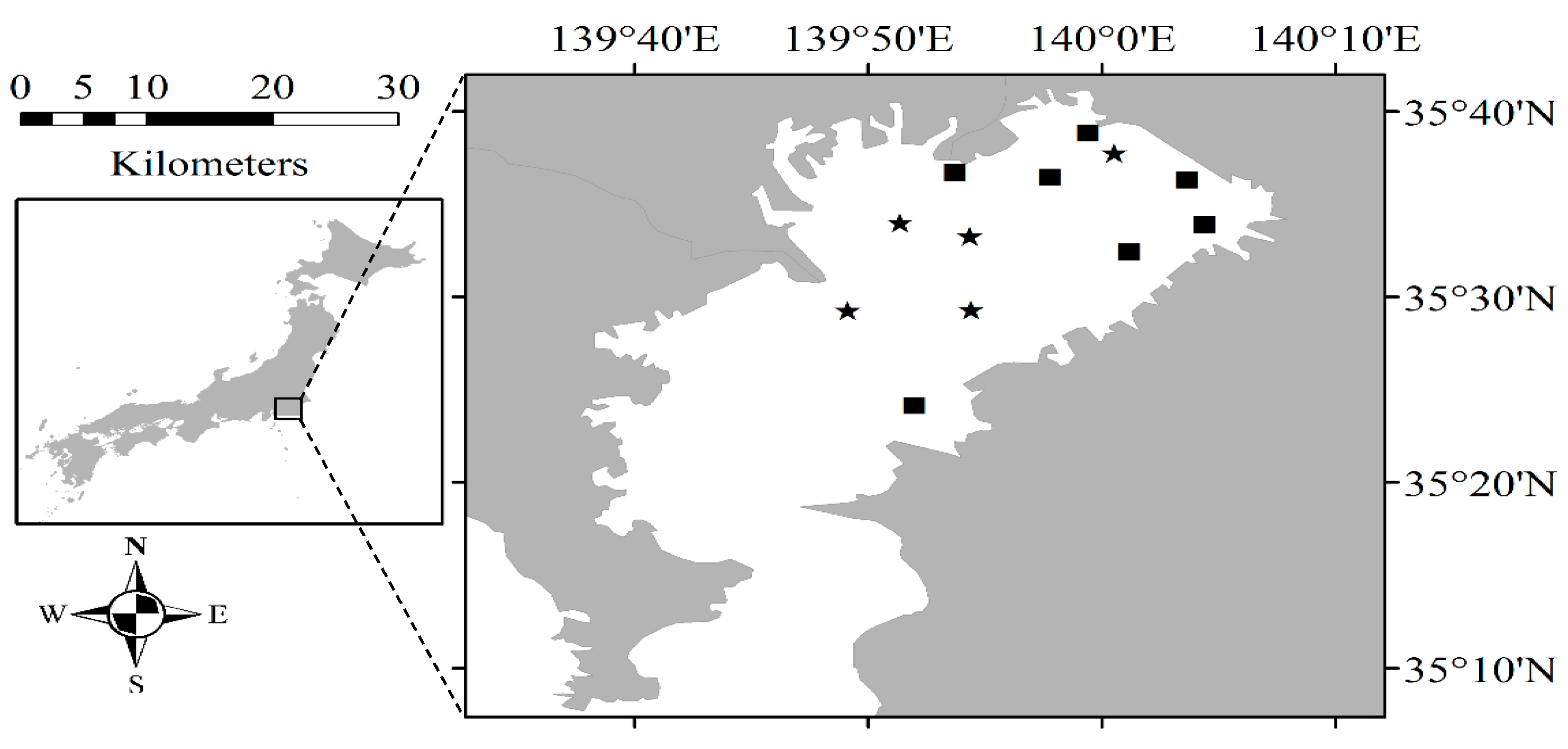
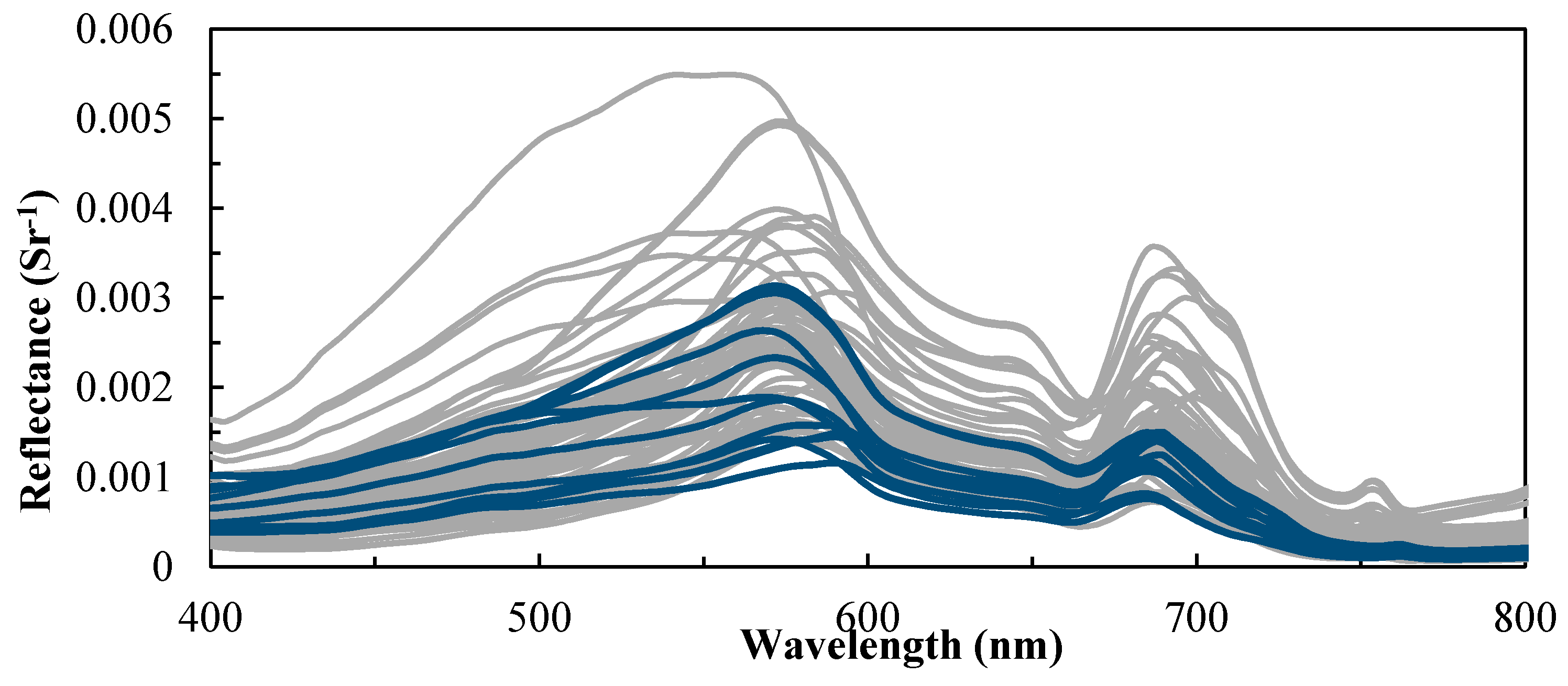
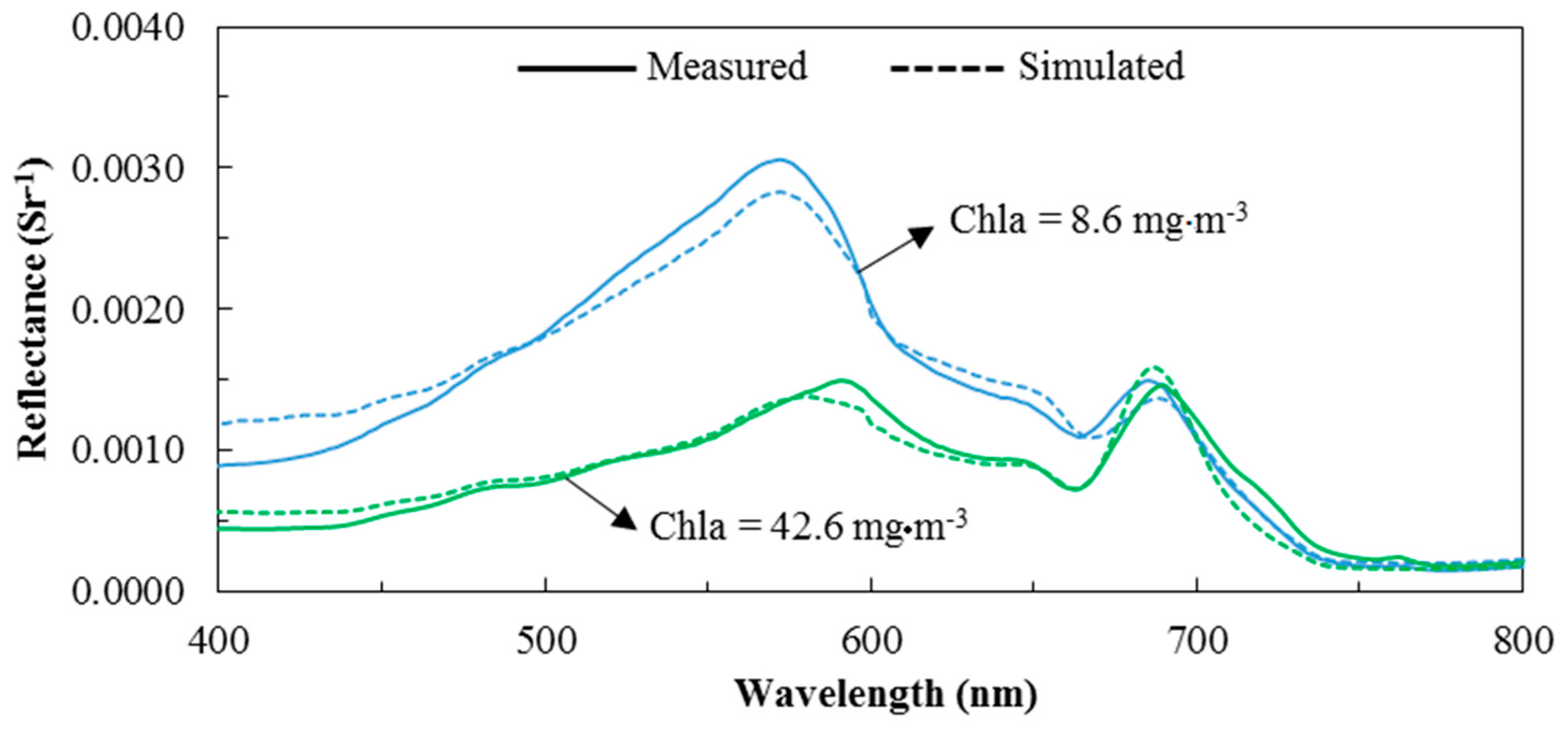
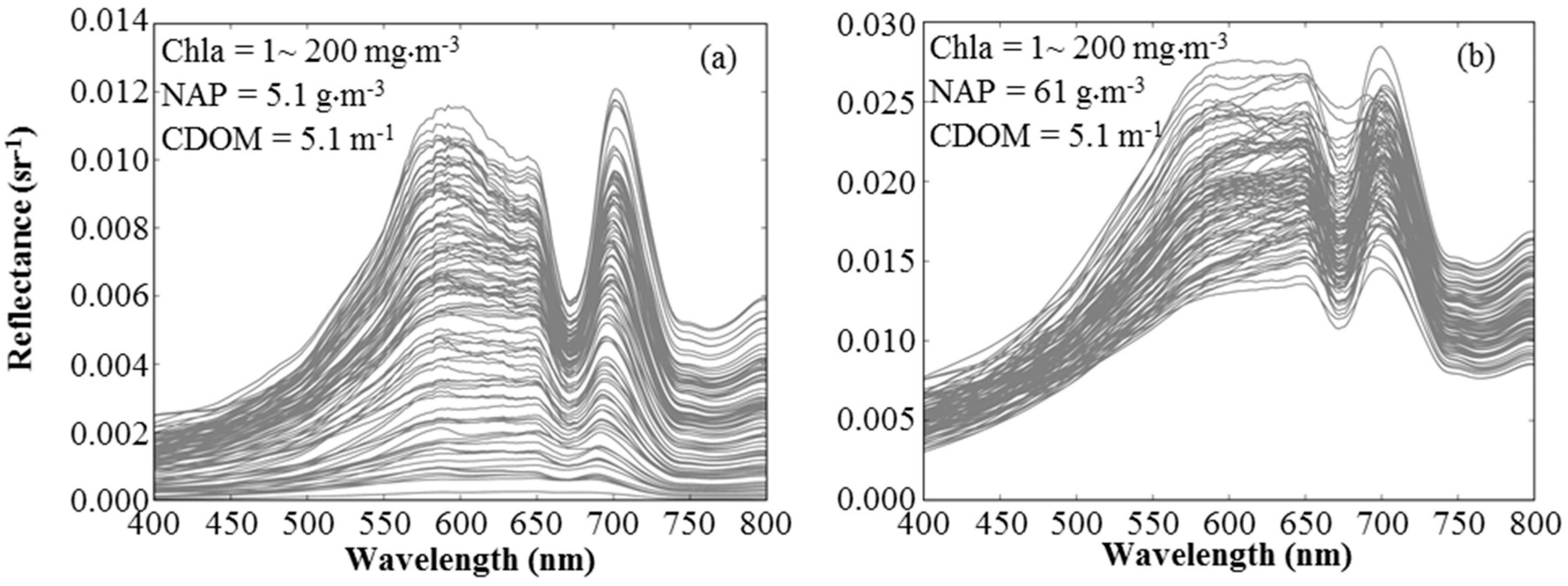
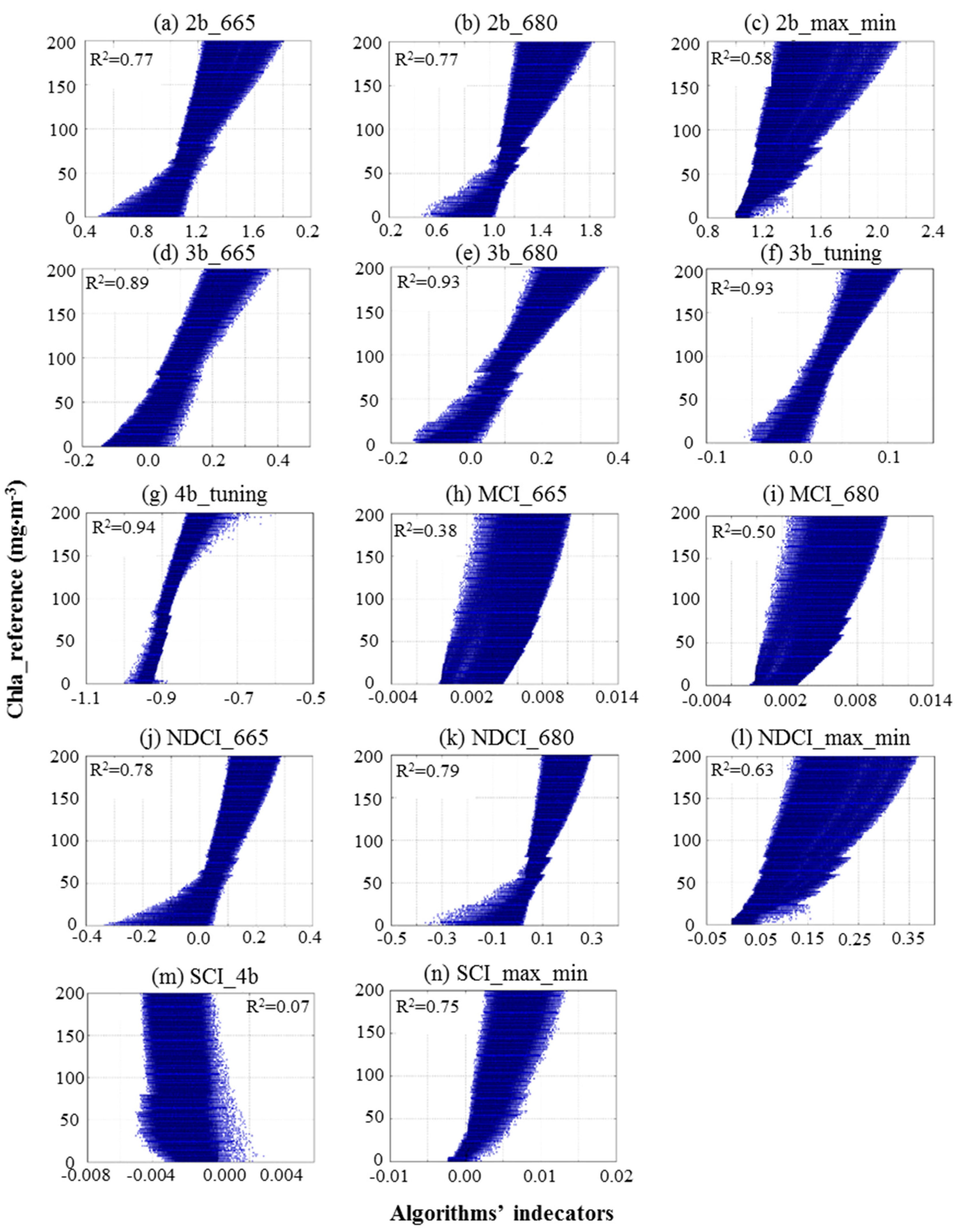
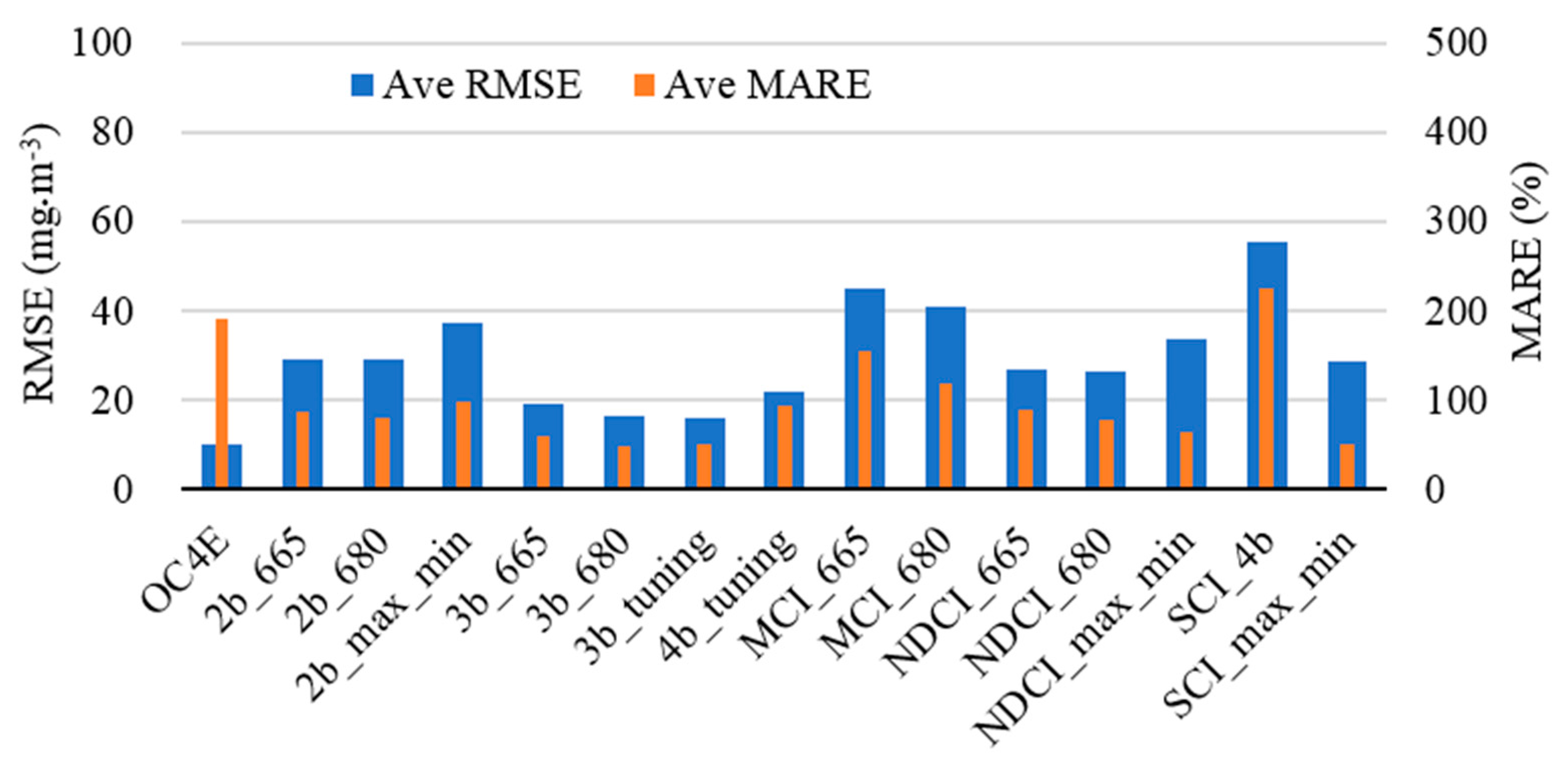
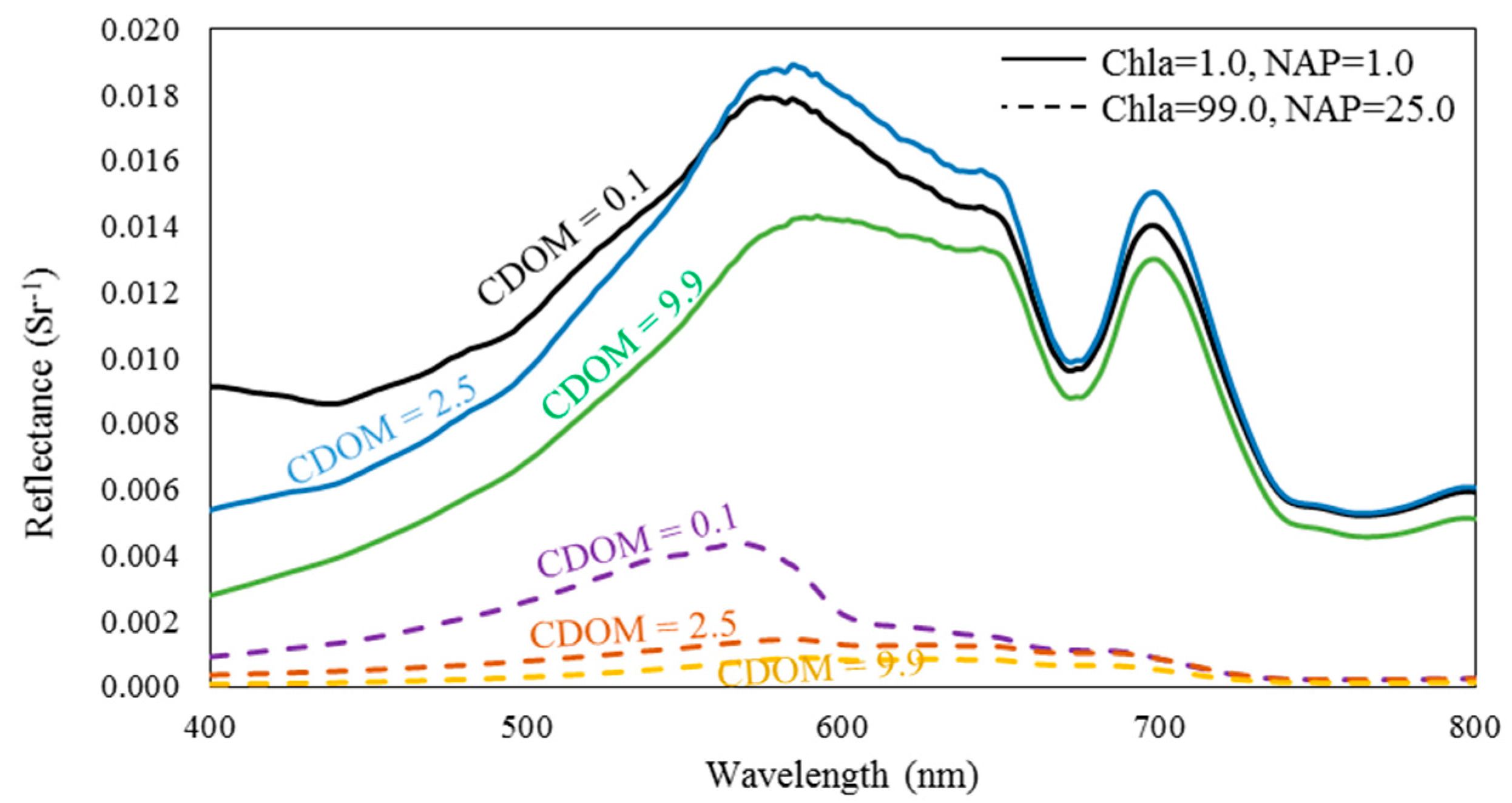
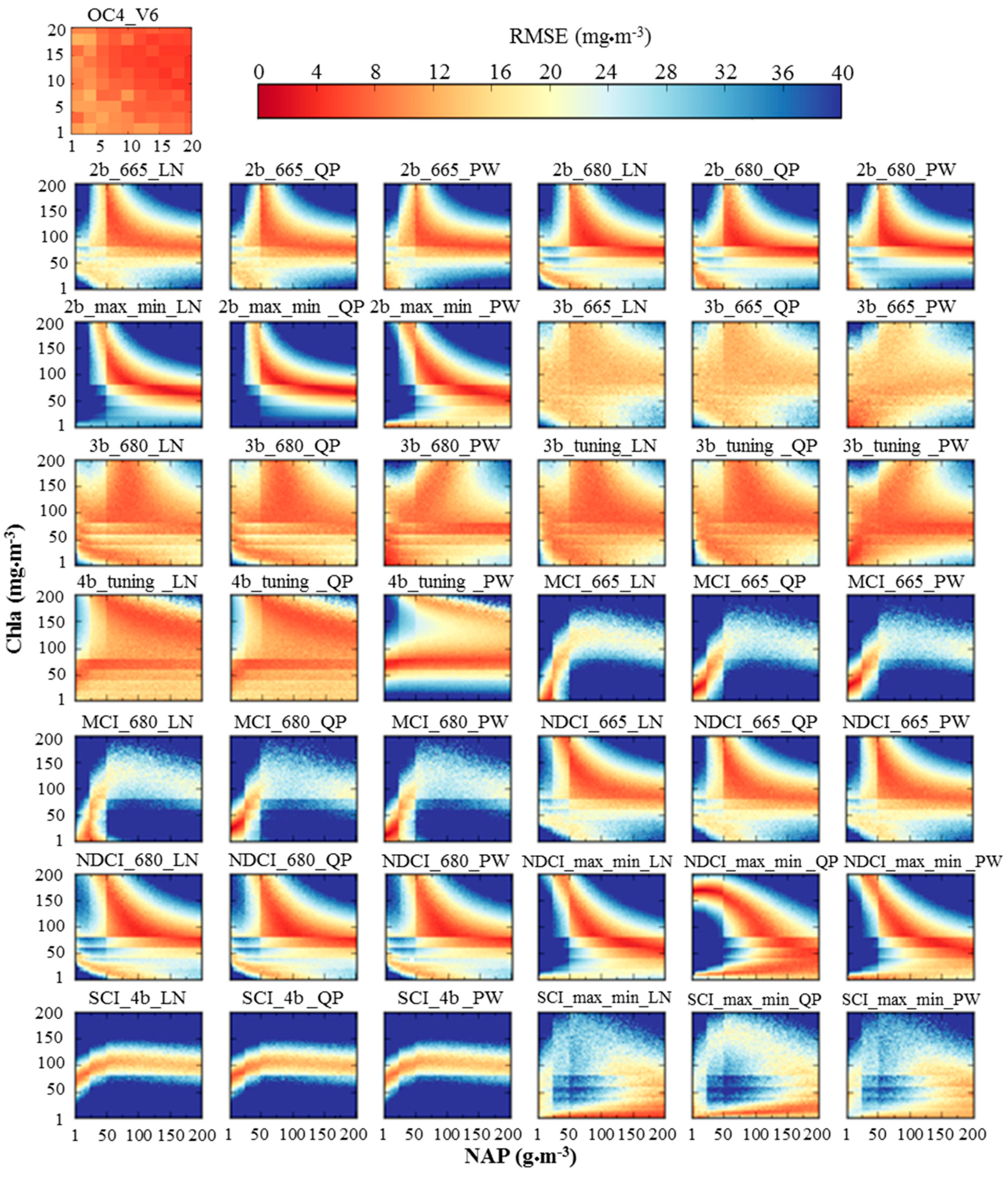

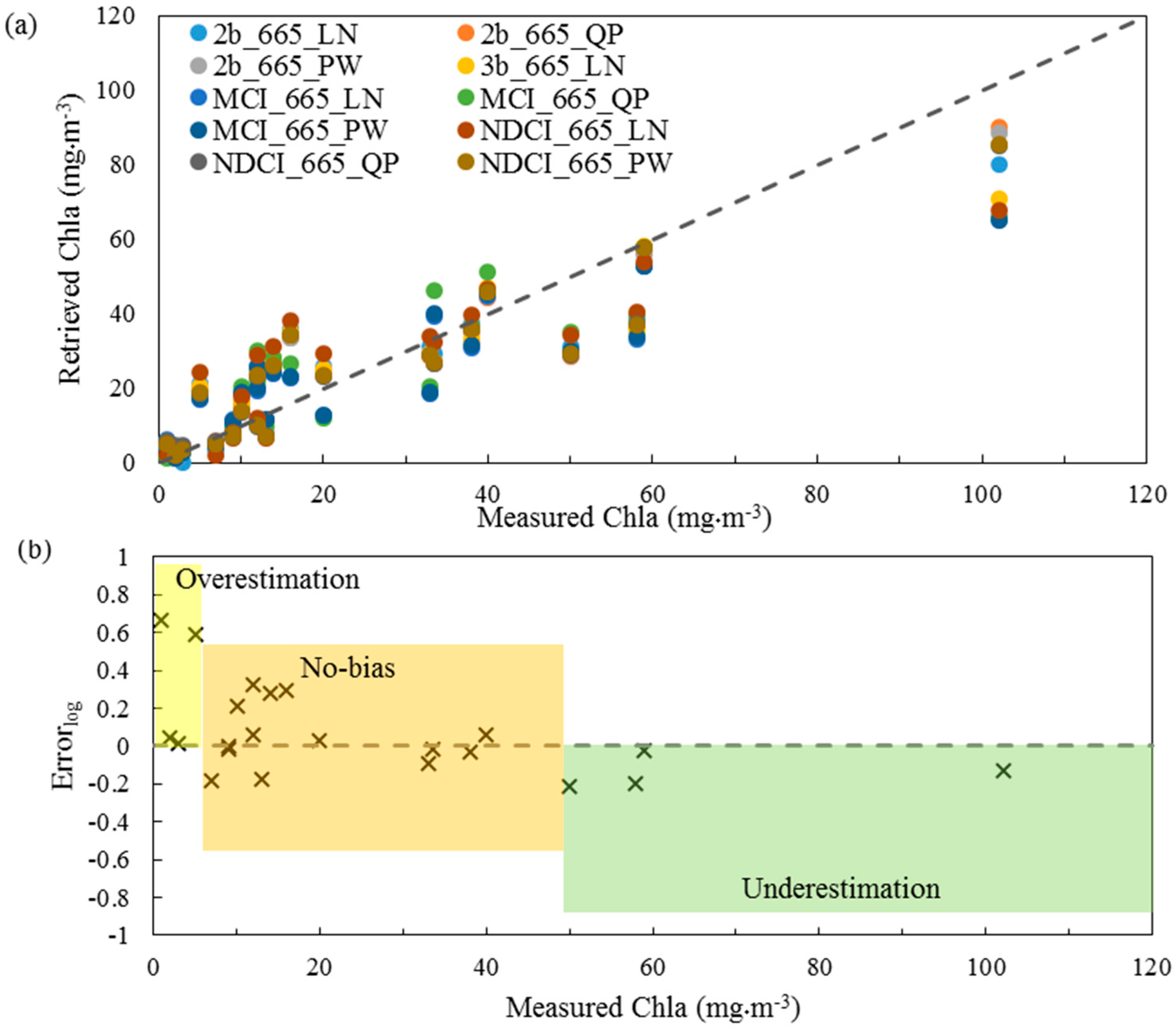
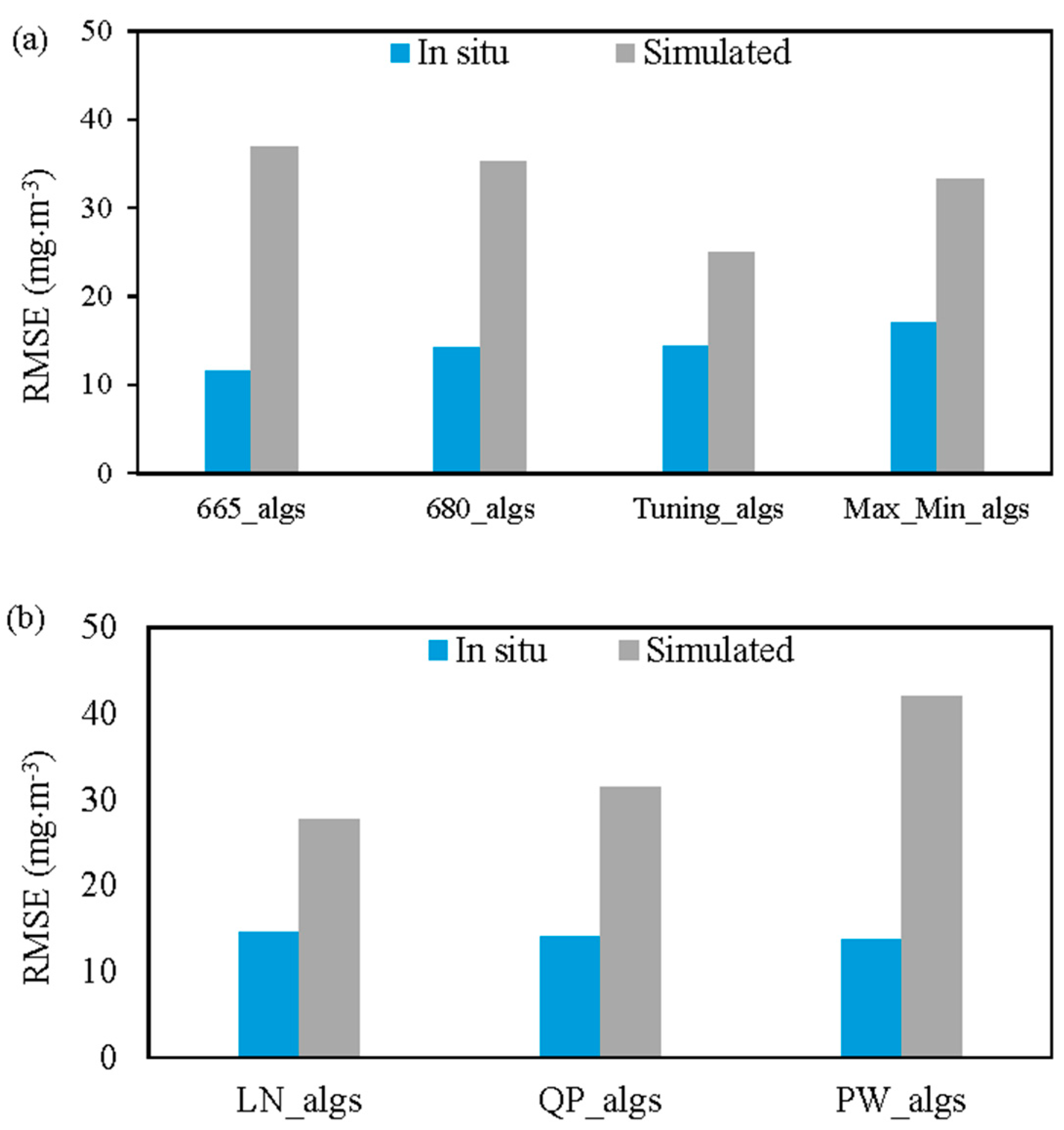
| Min | Max | Mean | Median | Stdv | CV (%) | |
|---|---|---|---|---|---|---|
| All samples (n = 70) | ||||||
| Chla (mg·m−3) | 2.90 | 97.32 | 24.86 | 16.50 | 21.76 | 87.53 |
| TSS (g·m−3) | 2.99 | 26.29 | 8.04 | 7.30 | 3.91 | 48.63 |
| ISS (g·m−3) | 0.50 | 17.20 | 3.78 | 3.16 | 2.72 | 71.81 |
| OSS (g·m−3) | 0.32 | 12.28 | 4.36 | 4.18 | 2.34 | 53.74 |
| Samples with IOPs (n = 12) | ||||||
| Chla (mg·m−3) | 2.90 | 42.60 | 18.31 | 11.85 | 14.99 | 81.87 |
| TSS (g·m−3) | 2.99 | 9.86 | 6.34 | 6.81 | 2.24 | 35.38 |
| ISS (g·m−3) | 0.81 | 6.13 | 2.96 | 2.22 | 1.63 | 55.24 |
| OSS (g·m−3) | 0.96 | 7.16 | 3.39 | 2.90 | 1.75 | 51.63 |
| aph (440) (m−1) | 0.23 | 1.03 | 0.65 | 0.60 | 0.27 | 41.30 |
| aNAP (440) (m−1) | 0.14 | 0.34 | 0.22 | 0.21 | 0.07 | 31.75 |
| aCDOM (440) (m−1) | 0.06 | 0.47 | 0.25 | 0.19 | 0.14 | 56.23 |
| bb,p (442) (m−1) | 0.01 | 0.04 | 0.02 | 0.03 | 0.01 | 41.16 |
| SIOPs | Tokyo Bay * | Wide Range ** |
|---|---|---|
| a*NAP (440) m2·g−1 | 0.03483 | 0.02–0.1 |
| a*CDOM (440) | 1.0 | 1.0 |
| b*b,ph (550) | 0.000204 | 0.0001–0.002 |
| b*b,NAP (550) | 0.00296 | 0.001–0.02 |
| SNAP | 0.00899 | 0.007–0.015 |
| SCDOM | 0.01547 | 0.01–0.02 |
| n | 1.25848 | 0.5–2.2 |
| No. | Investigated Algorithms | Algorithms’ Abbreviation | Proposed Bands | References | |||
|---|---|---|---|---|---|---|---|
| λ1 | λ2 | λ3 | λ4 | ||||
| 1 | Ocean Color 4 | OC4E | 443 | 490 | 510 | 560 | O’Reilly et al. [10] |
| 2 | Two-band ratio | 2b_665 | 665 | 709 | Gons [13] | ||
| 3 | 2b_680 | 680 | 709 | ||||
| 4 | 2b_max_min | Min (660−690) | Max (690–710) | ||||
| 5 | Three-band algorithm | 3b_665 | 665 | 709 | 754 | Dall’Olmo et al. [15] | |
| 6 | 3b_680 | 680 | 709 | 754 | |||
| 7 | 3b_tuning | Band tuning | |||||
| 8 | Four-band algorithm | 4b_tuning | Band tuning | Le et al. [31] | |||
| 9 | Maximum chlorophyll index | MCI_665 | 665 | 709 | 754 | Gower et al. [34] | |
| 10 | MCI_680 | 680 | 709 | 754 | |||
| 11 | Normalized difference chlorophyll index | NDCI_665 | 665 | 709 | Mishra et al. [32] | ||
| 12 | NDCI_680 | 680 | 709 | ||||
| 13 | NDCI_max_min | Min (660–690) | Max (690–710) | ||||
| 14 | Synthetic chlorophyll index | SCI_4b | 560 | 620 | 665 | 681 | Shen et al. [35] |
| 15 | SCI_max_min | Max (540–590) | Max (630–650) | Min (660–690) | Max (690–710) | ||
| Algorithms | Calibration | Validation | |||||
|---|---|---|---|---|---|---|---|
| R2 | a | b | c | R2 | RMSE | MARE | |
| OC4E | 0.05 | --- | --- | --- | --- | 9.89 | 191.79 |
| 2b_665_LN | 0.77 | 304.32 | −261.24 | --- | 0.77 | 27.50 | 81.86 |
| 2b_665_QP | 0.75 | 110.24 | 30.51 | −94.57 | 0.75 | 29.08 | 81.23 |
| 2b_665_PW | 0.72 | 16.46 | −8.21 | 1.88 | --- | 30.66 | 98.62 |
| 2b_680_LN | 0.78 | 295.80 | −254.96 | --- | 0.78 | 27.33 | 70.58 |
| 2b_680_QP | 0.75 | 104.92 | 29.94 | −90.03 | 0.75 | 29.15 | 73.82 |
| 2b_680_PW | 0.72 | 14.63 | −6.79 | 1.92 | 0.72 | 30.85 | 96.34 |
| 2b_max_min_LN | 0.58 | 213.29 | −182.64 | --- | 0.58 | 37.39 | 104.33 |
| 2b_max_min_QP | 0.53 | 62.12 | 25.42 | −45.29 | 0.53 | 39.44 | 126.63 |
| 2b_max_min_PW | 0.63 | 2002.34 | −2002.34 | 0.72 | 0.63 | 34.98 | 61.85 |
| 3b_665_LN | 0.89 | 626.91 | 31.19 | --- | 0.90 | 18.71 | 59.50 |
| 3b_665_QP | 0.89 | 30.27 | 620.36 | 31.31 | 0.90 | 18.71 | 58.93 |
| 3b_665_PW | 0.88 | 66.33 | 9.32 | 1.62 | --- | 19.80 | 57.97 |
| 3b_680_LN | 0.93 | 624.45 | 27.70 | --- | 0.93 | 15.62 | 46.11 |
| 3b_680_QP | 0.93 | −109.79 | 650.00 | 27.09 | 0.93 | 15.58 | 48.82 |
| 3b_680_PW | 0.91 | 63.28 | 8.92 | 1.63 | --- | 17.55 | 48.40 |
| 3b_tuning_LN | 0.93 | 1931.03 | 34.98 | --- | 0.93 | 15.09 | 45.31 |
| 3b_tuning_QP | 0.93 | −1121.35 | 2007.35 | 34.61 | 0.93 | 15.05 | 46.90 |
| 3b_tuning_PW | 0.91 | 137.36 | 7.98 | 1.79 | --- | 17.46 | 58.79 |
| 4b_tuning_LN | 0.94 | 1315.75 | 1252.01 | --- | 0.93 | 14.73 | 40.10 |
| 4b_tuning_QP | 0.94 | 41.99 | −37.02 | 32.41 | 0.94 | 25.61 | 118.63 |
| 4b_tuning_PW | 0.82 | −0.03 | 0.96 | −291.39 | 0.81 | 25.61 | 118.63 |
| MCI_665_LN | 0.38 | 19,068.81 | −9.17 | --- | 0.38 | 45.45 | 154.44 |
| MCI_665_QP | 0.40 | 1,208,885.88 | 6474.20 | 19.05 | 0.40 | 44.83 | 152.70 |
| MCI_665_PW | 0.40 | 62.74 | 1.63 | 6.63 | 0.40 | 44.77 | 155.56 |
| MCI_680_LN | 0.50 | 20,525.57 | −8.56 | --- | 0.50 | 40.88 | 115.11 |
| MCI_680_QP | 0.50 | 1,296,821.88 | 7055.46 | 21.35 | 0.50 | 40.76 | 123.71 |
| MCI_680_PW | 0.50 | 3201.62 | 4.90 | 1.48 | 0.50 | 40.67 | 116.69 |
| NDCI_665_LN | 0.78 | 724.11 | 41.93 | --- | 0.78 | 27.18 | 93.75 |
| NDCI_665_QP | 0.78 | 462.70 | 661.01 | 41.73 | 0.78 | 26.90 | 83.78 |
| NDCI_665_PW | 0.71 | 3.88 | 1.30 | 3.61 | --- | --- | --- |
| NDCI_680_LN | 0.79 | 720.36 | 38.49 | --- | 0.79 | 26.56 | 80.09 |
| NDCI_680_QP | 0.79 | 229.99 | 684.93 | 38.68 | 0.79 | 26.49 | 75.50 |
| NDCI_680_PW | 0.77 | 3.53 | 1.29 | 2.53 | --- | --- | --- |
| NDCI_max_min_LN | 0.63 | 635.72 | 15.15 | --- | 0.63 | 34.98 | 76.17 |
| NDCI_max_min_QP | 0.70 | −2220.14 | 1309.20 | −23.60 | 0.70 | 31.71 | 60.07 |
| NDCI_max_min_PW | 0.65 | 1819.05 | 0.22 | 0.84 | 0.65 | 34.02 | 57.33 |
| SCI_4b_LN | 0.07 | −16,818.44 | 61.55 | --- | 0.07 | 55.53 | 223.13 |
| SCI_4b_QP | 0.07 | 798,889.88 | −12,357.51 | 66.96 | 0.07 | 55.59 | 226.13 |
| SCI_4b_PW | 0.08 | −39,036.16 | 112.38 | 0.87 | --- | 55.52 | 222.66 |
| SCI_max_min_LN | 0.75 | 18,622.68 | 21.93 | --- | 0.75 | 28.85 | 41.88 |
| SCI_max_min_QP | 0.77 | −824,219.81 | 25,764.77 | 12.42 | 0.77 | 27.98 | 52.44 |
| SCI_max_min_PW | 0.74 | 6639.74 | 15.67 | 1.22 | 0.74 | 29.58 | 56.79 |
| Frequency | ||
|---|---|---|
| Algorithms | All 15 Algorithms (%) | Multi-Band Algorithms Only (%) |
| OC4E | 0.63 | 0.76 |
| 2b_665_QP | 0.49 | 2.12 |
| 2b_680_QP | 3.55 | 12.08 |
| 2b_max_min_QP | 5.35 | --- |
| 3b_665_QP | 1.45 | 8.8 |
| 3b_680_QP | 11.43 | 60.52 |
| 3b_tuning_QP | 33.19 | --- |
| 4b_tuning_QP | 13.04 | --- |
| MCI_665_QP | 0.87 | 1.64 |
| MCI_680_QP | 0.92 | 1.16 |
| NDCI_665_QP | 1.54 | 4.03 |
| NDCI_680_QP | 4.58 | 7.24 |
| NDCI_max_min_QP | 18.75 | --- |
| SCI_4b_QP | 1.02 | 1.65 |
| SCI_max_min_QP | 3.19 | --- |
| Calibration | Validation | ||||||
|---|---|---|---|---|---|---|---|
| Algorithms | R2 | a | b | c | R2 | RMSE | MARE |
| OC4E | 0.47 | --- | --- | --- | --- | 21.28 | 51.55 |
| 2b_665_LN | 0.61 | 64.78 | −39.70 | --- | 0.82 | 10.65 | 75.14 |
| 2b_665_QP | 0.62 | 22.91 | 13.78 | −13.88 | 0.85 | 9.64 | 63.38 |
| 2b_665_PW | 0.62 | 19.01 | −9.35 | 1.38 | 0.85 | 9.70 | 61.91 |
| 2b_680_LN | 0.61 | 133.70 | −66.84 | --- | 0.65 | 14.50 | 53.62 |
| 2b_680_QP | 0.64 | 171.95 | −120.72 | 22.83 | 0.70 | 13.98 | 77.76 |
| 2b_680_PW | 0.65 | 31.51 | −14.01 | 1.50 | 0.69 | 13.97 | 54.99 |
| 2b_max_min_LN | 0.35 | 39.58 | −38.36 | --- | 0.58 | 16.23 | 100.85 |
| 2b_max_min_QP | 0.38 | −28.68 | 138.09 | -118.21 | 0.46 | 17.97 | 127.73 |
| 2b_max_min_PW | 0.35 | 56.40 | −56.40 | 0.92 | 0.57 | 16.37 | 106.55 |
| 3b_665_LN | 0.54 | 215.91 | 24.43 | --- | 0.77 | 12.11 | 84.98 |
| 3b_665_QP | 0.55 | −341.33 | 246.28 | 27.00 | 0.69 | 13.62 | 103.70 |
| 3b_665_PW | 0.54 | 218.32 | 24.71 | 1.00 | --- | 12.88 | 75.31 |
| 3b_680_LN | 0.70 | 547.28 | 71.46 | --- | 0.60 | 15.96 | 112.84 |
| 3b_680_QP | 0.71 | 1524.13 | 749.73 | 75.25 | 0.66 | 14.18 | 81.92 |
| 3b_680_PW | 0.72 | 137.32 | 20.28 | 1.44 | --- | 14.40 | 66.97 |
| 3b_tuning_LN | 0.72 | 580.64 | 68.08 | --- | 0.61 | 15.51 | 124.89 |
| 3b_tuning_QP | 0.73 | 1923.03 | 804.47 | 71.34 | 0.69 | 13.79 | 107.45 |
| 3b_tuning_PW | 0.73 | 122.83 | 16.73 | 1.52 | --- | 13.68 | 97.76 |
| 4b_tuning_LN | 0.70 | 334.81 | 59.03 | --- | 0.60 | 15.71 | 120.98 |
| 4b_tuning_QP | 0.71 | 452.07 | 399.09 | 58.98 | 0.66 | 14.20 | 106.46 |
| 4b_tuning_PW | 0.71 | 79.25 | 16.46 | 1.46 | --- | 13.73 | 91.86 |
| MCI_665_LN | 0.63 | 53,369.70 | 3.50 | --- | 0.80 | 12.45 | 70.25 |
| MCI_665_QP | 0.67 | −30,829,280.00 | 95,144.16 | −3.75 | 0.73 | 12.80 | 78.27 |
| MCI_665_PW | 0.64 | 78,770.46 | 2.41 | 0.92 | 0.79 | 12.49 | 67.51 |
| MCI_680_LN | 0.63 | 83,225.49 | 20.74 | --- | 0.75 | 13.63 | 106.53 |
| MCI_680_QP | 0.65 | −43,715,440.00 | 104,539.34 | 22.42 | 0.71 | 13.57 | 93.69 |
| MCI_680_PW | 0.63 | 103,293.36 | 24.58 | 0.95 | 0.74 | 13.65 | 107.54 |
| NDCI_665_LN | 0.58 | 132.06 | 28.17 | --- | 0.73 | 12.87 | 93.67 |
| NDCI_665_QP | 0.62 | 254.63 | 134.28 | 22.35 | 0.85 | 9.87 | 70.40 |
| NDCI_665_PW | 0.62 | 7.19 | 3.28 | 2.63 | 0.85 | 9.87 | 60.69 |
| NDCI_680_LN | 0.57 | 190.57 | 62.13 | --- | 0.63 | 15.01 | 61.02 |
| NDCI_680_QP | 0.66 | 628.31 | 415.40 | 75.40 | 0.69 | 13.93 | 83.35 |
| NDCI_680_PW | 0.65 | 25.16 | 9.68 | 1.89 | 0.68 | 14.05 | 52.37 |
| NDCI_max_min_LN | 0.37 | 140.87 | −5.21 | --- | 0.52 | 16.91 | 118.44 |
| NDCI_max_min_QP | 0.37 | 16.69 | 133.54 | −4.62 | 0.53 | 16.84 | 116.43 |
| NDCI_max_min_PW | 0.37 | 54.45 | 0.01 | 1.29 | 0.55 | 16.51 | 100.26 |
| SCI_4b_LN | 0.11 | 25,685.39 | 1.36 | --- | 0.14 | 22.80 | 297.10 |
| SCI_4b_QP | 0.12 | −9,940,877.00 | 47,537.92 | −9.19 | 0.11 | 23.07 | 311.24 |
| SCI_4b_PW | 0.12 | 178,020.55 | −44.51 | 0.68 | 0.12 | 22.99 | 305.93 |
| SCI_max_min_LN | 0.52 | 36,992.36 | −20.91 | --- | 0.51 | 17.62 | 131.03 |
| SCI_max_min_QP | 0.52 | −833,195.81 | 39,538.18 | −22.57 | 0.50 | 17.60 | 130.40 |
| SCI_max_min_PW | 0.52 | 12,071.70 | −3.96 | 1.32 | 0.51 | 17.77 | 136.53 |
© 2017 by the authors. Licensee MDPI, Basel, Switzerland. This article is an open access article distributed under the terms and conditions of the Creative Commons Attribution (CC BY) license (http://creativecommons.org/licenses/by/4.0/).
Share and Cite
Salem, S.I.; Higa, H.; Kim, H.; Kobayashi, H.; Oki, K.; Oki, T. Assessment of Chlorophyll-a Algorithms Considering Different Trophic Statuses and Optimal Bands. Sensors 2017, 17, 1746. https://doi.org/10.3390/s17081746
Salem SI, Higa H, Kim H, Kobayashi H, Oki K, Oki T. Assessment of Chlorophyll-a Algorithms Considering Different Trophic Statuses and Optimal Bands. Sensors. 2017; 17(8):1746. https://doi.org/10.3390/s17081746
Chicago/Turabian StyleSalem, Salem Ibrahim, Hiroto Higa, Hyungjun Kim, Hiroshi Kobayashi, Kazuo Oki, and Taikan Oki. 2017. "Assessment of Chlorophyll-a Algorithms Considering Different Trophic Statuses and Optimal Bands" Sensors 17, no. 8: 1746. https://doi.org/10.3390/s17081746





